Peripheral Vascular Disease and Diabetes have been closely linked with each other. Compared to the general population, peripheral disease is actually very common in individuals with diabetes. This therefore, means that unless appropriate preventive measures are taken, a person with diabetes is more liable to build up peripheral vascular illness. In other words, diabetes is a major risk factor for peripheral vascular disease.
Peripheral vascular disease is a term commonly used by doctors to refer to peripheral arterial disease or peripheral artery disease (PAD), meaning occlusion or narrowing by atherosclerotic plaques of the arteries just outside of the brain and heart.
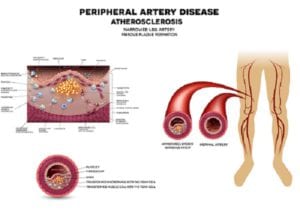
PAD is a simply a form of arterial deficiency, which simply means that blood circulation through the arteries, which are the blood vessels that basically transport blood from the heart to the rest of the body, is decreased.
Diabetes is a health condition whereby your body is not able to use a sugar known as glucose to generate energy. As a result of this, your blood sugar level rises and becomes very high. It is a lifelong or chronic condition. Diabetes puts you at very high risk for peripheral vascular disease or peripheral arterial disease.
If you have this disease, the blood vessels in the feet and further pieces of your structure of body are expected unhealthy as well. That definitely puts you at very high risk for many other serious health problems.
How Diabetes Can Lead to Peripheral Vascular Disease
Diabetes is a chronic health condition that can potentially hurt your arteries. If you have diabetes and it is not controlled very well, the blood sugar level in your blood will be very high. If this happens, the walls of your arteries might become very rough. As a result, plaque can build up on the walls of the artery. In case you don’t know, plaque is simply a waxy substance that can be found in the blood.
Plaque contains cholesterol. Therefore, it makes it very hard for blood to flow freely through the arteries as it should. This limits blood flow mainly to your legs and arms, causing damage in various tissues.
Your foot is most at risk of the tissue damage and this explains why the feet are usually the most affected. The tissue damage can be very bad in some patients and there may be a need to remove the feet, toes, or even the legs.
To avoid damage of tissues and potential need to amputate the legs, cholesterol and sugar levels should be controlled. This will lower the risk of the patient developing peripheral vascular disease as well. Controlling of cholesterol and sugar levels is done with exercise and proper nutrition.

Medication and weight loss may also help a great deal. Besides, proper foot care is also very important for patients with peripheral vascular disease.
From this explanation, you can clearly see that peripheral vascular disease and diabetes are close related to each other and the latter increases the risk of the patient for the former. To understand the relationship between these two diseases further, you should also know what peripheral vascular disease is and what causes it. Read on to learn just that.
What is Peripheral Vascular Disease?
Peripheral vascular disease is a health condition whereby the artery in the patient’s legs, moreover sometimes in the arms, is lessened in particular by the greasy sign swelling. This disease is very common among people with diabetes. As mentioned earlier, this disease is twenty times more common in patients with diabetes that those without diabetes.
People with diabetes have high blood sugar levels and cholesterol levels in their blood. This results into chronic high blood glucose, since glucose is the type of sugar that the body of diabetic patient is not able to utilize to generate energy.
High blood glucose in your blood increases your risk of developing this health condition known as peripheral vascular disease. This is especially true if diabetes is not controlled appropriately.
Therefore, if you are diabetic, you should take appropriate measures to manage your condition. Otherwise, you will be increasing your risk of developing other diseases and conditions such as peripheral vascular disease. You should focus more on reducing the levels of blood glucose in your blood in order to avoid developing peripheral vascular disease.
Symptoms
Knowing the symptoms of this disease is very important as you will be able to identify them and start taking appropriate medication before any potential further damage. The symptoms of this disease can be harsher in citizens who have diabetes. This is one of the main reasons why peripheral vascular disease and diabetes disease are closely related to each other.
Intermittent claudication remains one of the basic signs of this disease. Intermittent claudicating is simply limiting foot ache which is typically brought about by walking or jogging and is relieved simply by having a rest. The pain is normally brought about by insufficient deliver of blood.
So, if you experience spasm leg pain after walking a short distance and it disappears when you take a rest, then you are probably suffering from peripheral vascular disease.
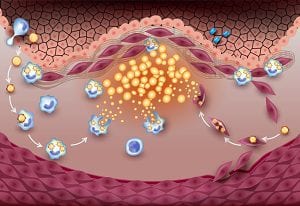
Fatty plaque buildup or atherosclerosis in the arteries is the source of intermittent claudication. As the arterial blockage continues to progress, you will start experiencing the pain even after walking just single chunk or less. It may actually start to interfere with your daily activities and life in general. This will definitely necessitate treatment.
The second most common symptom of this illness is that very minor scrapes or cuts on the legs do not cure. So, if you have a minor cut on your feet and it is refusing to heal even after treating the wound, then you should get tested for this disease especially if you have diabetes. You might have bruises in your feet should take few days to heel just like bruises in your hands and other parts of the body.
Watch the Video Below for More
About Peripheral Vascular Disease!
Rest pain can also occur in the legs especially when the artery occlusion has become so severe that there is not enough oxygen and blood give to the legs even when you are just resting. This usually signals a more serious form of nonessential situations. Rest pain normally affects the patient’s feet. The pain is typically severe and usually occurs at night when you are lying down as you are facing up.
There are other symptoms and they include:
- A feeling of coldness in the feet or legs
- Numbness of the feet or legs
- Painful ulcers with sometimes gangrene especially in areas of the feet where the blood flow is lost
- Thickening of the toenails or hair loss on the top of the patient’s feet
- Feet changing their natural color whereby the feet turn dusky red when in dependent position, and turn pale when in elevated position
- Atrophy and weakness of the calf muscle
Prevention and Treatment
Peripheral vascular disease and diabetes disease have become very common these days. It is therefore very important that you prevent these diseases. And if you already have them, you should work closely with your doctor to manage and treat them.
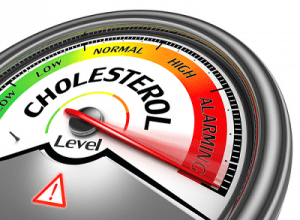
The common denominator in both diseases is high sugar and cholesterol levels in the blood. To keep these diseases at bay, just ensure that your blood sugar and cholesterol remain at the required levels.
Peripheral vascular disease may in the long run develop into an extremely threatening health problem if not treated well. People with very poor circulation especially in feet are most likely to develop foot ulcers that don’t heel and there may be a call for for exclusion ultimately.
If someone experiences extremely time-consuming treating of the wounds and minor cuts in their feet or they face irregular claudicating, then they should consult their doctor as soon as possible.
The above-mentioned health problem could easily sometimes be treated with endovascular technique or surgery. Bypass surgery usually entails attaching the blood vessel as of a different part of your structure to go around the obstruction of blood in the influenced area in order to restore usual blood circulation.
Such types of techniques include the use of lasers, and hash away the sign puts, as well as percutaneous transluminal angioplasty (also known as balloon angioplasty) for some better advantages.
Such dealings have a high difficulty rate and just partial hit speed in citizens who having both the mentioned diseases without any kind of doubt. For this reason, this surgical procedure can be typically the superlative choice. However, you should leave the decision to your health-care team to decide on which treatment option is best for you.
Besides taking preventive measures, the best thing you can do is to see your health care provider immediately you see any of the signs of these diseases.
Enhanced level of glucose with blood is one of the best ways to prevent this problem as well as diabetes. Besides, there are also other steps you could choose to keep these diseases at bay. For instance, you should always stick to a better meal, which could decrease saturated fat and cholesterol.
You should also quit smoking as it affects the organs that ensure your blood is free from excess cholesterol and glucose. Precisely, smoking affects your liver, lungs, heart and kidneys.
You should also avoid sedentary lifestyle and instead adopt an active lifestyle. You can achieve this by walking every day, jogging every day, or engaging in activities such as swimming and hiking on a regular basis.
Being active, especially taking a walk and engaging in activities that involve mostly your legs is a great way to advance recovered blood flow in foots. You can also join a dance program as dancing will also promote good blood circulation.
Having diabetes doesn’t mean that you cannot prevent peripheral vascular disease. Besides the measures discussed above, you can also avoid this problem disease by taking blood-thinning drugs.
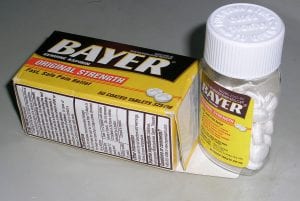
Aspirin is a common and among the most popular blood-thinning drugs you could have to prevent this disease if you have diabetes. It is important to remember that you should only take any blood-thinning drug under the supervision of your doctor.
Lifestyle Changes for People with Peripheral Vascular Disease And Diabetes
Treatment of the mentioned problem and diabetes disease not only includes medications and surgery but also angioplasty, supervised exercise and lifestyle changes. The lifestyle changes you should adopt include developing an exercise routine and sticking to a healthy diet that can help in lowering your blood cholesterol and sugar levels and other lipid levels. Healthy diet can always help in controlling your blood pressure.
If you smoke cigarettes, then you must find a way to quit. Smoking cessation has been identified to eliminate a major risk factor for progression of these diseases. It also lowers the incidences of amputations and pain at rest. Smoking cessation is also important to prevent stroke and heart attack, which are usually associated in the company of tangential vascular disease and diabetes disease.
You can also follow medical advice regarding lifestyle changes and medications to keep away other risk factors, such as high blood pressure and high lipid levels. Diabetes disease is the major risk factor for peripheral vascular disease. Therefore, keeping diabetes under control through medications and lifestyle changes is also another effective way diabetic patients can prevent peripheral vascular disease.
Risk Factors for Peripheral Vascular Disease and Diabetes
The mentioned disease and diabetes disease are closely associated because diabetes remains the most common risk factor for peripheral vascular disease. Besides diabetes, there are also other risk factors for this peripheral vascular disease. They include:
- Smoking
- High blood lipid levels (triglycerides and cholesterol)
- Inactivity
The risk factors for this disease and diabetes include physical inactivity, obesity or overweight, cigarette smoking, a family history of these diseases, hypertension or high blood pressure, a family history of diabetes or hypertension, high blood glucose and high blood cholesterol.
While anyone can suffer peripheral disease and diabetes disease at any age, people who are above 50 years of age are usually at the highest risk of these diseases. Based on statistics, these diseases are more common in men that in women.
Conclusion
Peripheral Vascular Disease and Diabetes are two things you obviously do not want to experience. But you now know that diabetes can cause peripheral vascular disease and you should be very aware of your health and eating habits along with an exercise regimen. You don’t have to wind up with either diabetes or peripheral vascular disease if you have your health under control.
Check Out Below the Best Way
to Lower Your Blood Sugar Fast!
Please share on social media below and forward this to others who need help and please leave any questions or comments you may have below. I would love to interact with you. Thank you for reading and I appreciate it!
- Amazon Kindle Edition
- Rothchild, Sascha (Author)
- English (Publication Language)
- 336 Pages - 04/19/2022 (Publication Date) - G.P. Putnam's Sons (Publisher)
- ✅ QUICK AND EASY TO USE: Care Touch blood sugar test kit delivers results in only 5 seconds with just a 0.5µL blood sample. There is no programming needed since our blood sugar monitor kit automatically recognizes batch codes encrypted on Care Touch glucose test strips. Our state-of-the-art glucometer kit with strips and lancets includes single-touch strip ejection, so you can hygienically remove used diabetic test strips.
- ✅ EASY DIABETIC MONITORING: The blood sugar monitor kit with strips is capable of saving up to 300 readings. The blood glucose test kit also provides a continuous 14-day average of your readings, making glucose monitoring easy for you and your healthcare provider.
- ✅ PORTABLE AND HASSLE-FREE: The diabetic testing kit comes with a handy glucometer case, which means you can check your blood sugar level at home or anywhere else while staying organized. The 10-depth lancing device and lancets will help make blood sugar testing almost painless and hassle-free.
- ✅ COMPLETE DIABETIC SET: The glucose meter kit with strips and lancets includes: (1) Care Touch Blood Sugar Meter, (100) Blood Glucose Test Strips for diabetes, (1) Lancing Device, (100) Lancets for diabetes testing, (1) 3 Volt Lithium Battery, (1) Glucose meter case for your blood sugar tester and diabetic supplies
- ✅ WE CARE BECAUSE YOU CARE: You care about your health, and we care about you. Care Touch is committed to providing the best quality blood glucose monitoring systems. Our care doesn’t end when your sugar tester diabetes kit arrives at your door. We’re fully dedicated to your satisfaction. If you have any questions or concerns about your glucose monitor kit with strips and lancets - contact us at any time.
- Amazon Prime Video (Video on Demand)
- English (Playback Language)
- English (Subtitle)
- PUREHEALTH RESEARCH - Blood Sugar Formula 3 Bottles
- MANUFACTURED in the USA! 365-DAY SATISFACTION GUARANTEED!
- A DOCTOR-APPROVED NATURAL FORMULA. Seventeen potent ingredients, each scientifically proven to have a significant effect at helping balance your glucose levels, improve glucose sensitivity, protect delicate cells from free radicals, and energy
- HIGH POTENCY. PureHealth Research experts scientifically enhance CHROMIUM with the Vitamin C, E, Mulberry Leaf, Bitter Melon, Cinnamon, L-Taurine, Berberin and other ingredients which are proven to help you support healthy blood glucose levels
- ONE CAPSULE DAILY, THREE BENEFITS: supports healthy sugar and carb absorption, supports insulin levels, supports cardiovascular health
- Scientifically formulated; great care was put into combining just the right amount of 20 different ingredients into a premium formula designed to support healthy blood sugar levels
- High potency support for 365 days a year; the unique combination in this blend is crafted to help support healthy glucose absorption and glucose production by your body; contains Gymnema, Alpha Lipoic Acid, Yarrow, Licorice, Cayenne, Banaba, Guggul, Bitter Melon, Juniper Berry, White Mulberry, L-Taurine & more
- One capsule twice a day, five benefits; (1) supports normal blood sugar levels; (2) supports weight control and energy; (3) supports healthy sugar and carb absorption; (4) supports insulin levels; (5) supports heart health; daily support for healthy blood glucose levels, 365 days a year
- Reliable; made in a GMP certified facility in America and third party safety tested for purity
- Great value for money; 120 vegetarian capsules for a 60 days supply
Last update on 2022-06-23 / Affiliate links / Images from Amazon Product Advertising API

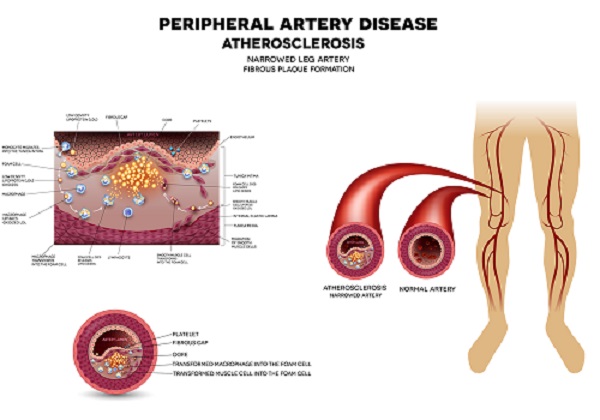








Even with all the advances in modern medicine, it is great to find natural ways to lower blood sugar and feel better.
Smokers should seriously consider finding ways to quit the cigarette habit in order to have the best health… In addition, they will reclaim a significant amount of money and time in their everyday life. Almost all of us can find ways to stay more active – even TV lovers can do a few sets of quick exercises while they enjoy their favorite shows. High cholesterol levels can be genetic, but a healthy diet can only help to keep levels as low as possible.
Thanks for sharing this helpful information!
Hey Aly 🙂
I agree and with medicine as an option, it is just a crutch and not a permanent solution the way natural ways can be.
Peripheral vascular disease is serious just as diabetes is and the two are connected.
In order to avoid both it is necessary to eat healthy, exercise, and of course NOT smoke! I never did thank God!
Basically one of the best things we can do is to keep moving. So watch the sugars and carbs and get off the couch!
Thank you for sharing! 🙂
Wow this information is incredible. My grandmother suffers from diabetes and is not one to take care of herself. Even after finding out she had diabetes! I had no idea that more diseases can come from the diabetes. I knew the diabetes itself could get worse. This very much worries me for her health. I’m so glad you offered ways to prevent it. Luckily I don’t see her having any symptoms of peripheral vascular disease but I’ll be sure to keep an eye out. Thank you so much for such useful information.
Hey Jordan! Thank you so much! I’m sorry to hear about your grandmother and her diabetes. Yes diabetes can cause other diseases and it’s just horrible what it can do to your body. Peripheral vascular disease is just one of the diseases it can cause. That’s why I wanted to write about it and cover the best ways to prevent and treat it. Let’s get blood sugars to normal levels and control diabetes! Thanks for sharing!
Thank you for this in depth post on Peripheral Vascular Disease, and how it relates to diabetes. As I age I am becoming more and more aware of what I can do to protect my health, and in particular aware of diabetes. I like the natural suggestion of increasing your activity, as I am not a smoker this does not relate to me. We often do not think of the domino effect one illness can have on your body. Are there any main foods you would suggest cutting out or down on to help lower the risk of diabetes, and therefore, Peripheral Vascular Disease?
Great reading, thanks.
Denise
Good evening Denise 🙂
I’m happy that you found my post helpful. It is harder to stay healthy as we age so we must do whatever it takes to be healthy.
Diabetes and peripheral vascular disease are very serious as I’m sure we all know. If we control our diabetes, we can also help ourselves from contracting other diseases and illnesses.
The more we move, the better off our health will be. Walk 10,000 steps a day or as many as you can but get up and move!
As far as foods go? On the home page of my website here, there is an entire category dedicated to foods for helping your blood sugars!
Thank you for sharing your comments! 🙂
Thank you for your post. I have diabetes, which was diagnosed last year. I think it is in the early stage. So far I don’t have apparent symptoms besides the high blood sugar, ranging from 120 to 150 without insulin. But it is under control when I use insulin.
The information on peripheral vascular disease is big warning to me. Although I am fine now, there is potential for me to develop into this illness if I don’t control my diabetes seriously.
Prevention is the best way to avoid the peripheral vascular disease. I am in a good position since I have no risk factor described by you. I need to focus on the blood glucose control.
It is kind of you sharing this useful information with us.
Hi Anthony!
So you’ve been diagnosed with type 2 diabetes? Not to panic! Bookmark my website and also take a look at the product reviews. There is a ton of information here that will help you 🙂
You don’t want peripheral vascular disease on top of the diabetes. Lower the blood sugars!
Check through my site! It is dedicated to lowering your blood sugars naturally. School yourself because that’s why I am here, to help you out.
Browse through the website and if you have an questions, feel free to contact me!
Good luck and thanks! 🙂